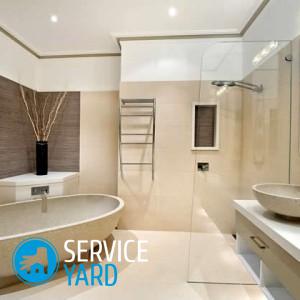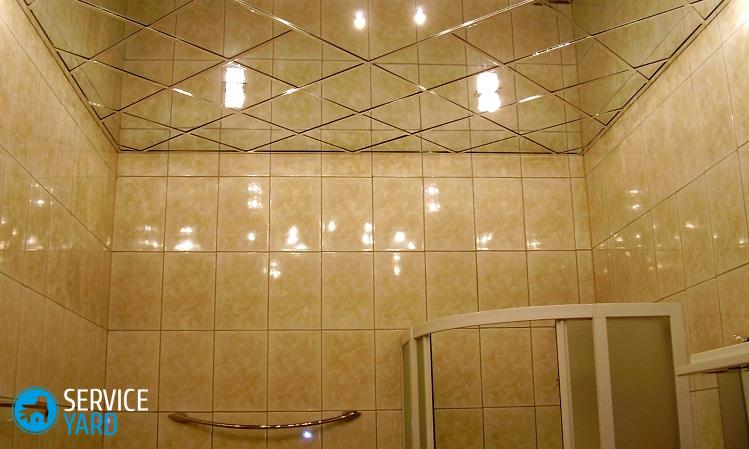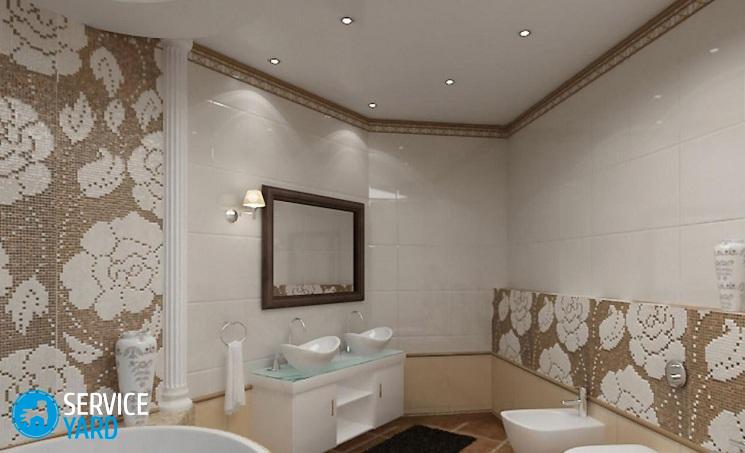DIY bathroom ceiling

Repair in the bathroom must be approached with all seriousness and responsibility, since all materials in this room are subjected to severe moisture tests, temperature extremes and insufficient air circulation. Today, the construction market has a huge assortment of finishing materials with high moisture resistance, which has a beautiful appearance. Our article will be devoted to the most simple and inexpensive solutions that will help to make the ceiling in the bathroom with your own hands without special skills and qualified training.
to contents ↑Material Selection Criteria
When planning a ceiling repair in a bathroom, first of all, pay attention to the quality of the finishing material. The basic rules for choosing a finish for the bathroom state that the selected material should have the following characteristics:
- High rate of moisture resistance.
- Resistance to frequent temperature changes.
- Resistance to chemicals.
- Easy to clean.
- Long term of operation.
If we are talking about repairing the ceiling in the bathroom, then the options are not so few:
- Painting. Advantages of finishing: lack of costs, speed of repair, unpretentiousness in leaving and fresh appearance. It should be noted that this traditional way of decorating the ceiling has recently lost its popularity due to a number of factors, since before proceeding with the painting, the surface must be carefully prepared in order to level it as much as possible and improve the adhesion of the paint layers. All preparatory measures require additional financial resources and time for their implementation.
- Stretch ceiling. This type of finish is quite optimal, since such ceilings will be strong enough, visually attractive and easy to care for. There are a huge number of colors and textures of the material, so everyone can make their choice, based on their own preferences and taste.
- Suspended ceiling. Used for this design is mainly moisture-proof drywall. Installation of drywall is carried out on steel rails attached to the ceiling.
- Plastic panels. This is one of the most reasonable choices, since such a finish has quite good performance characteristics. Plastic ceiling panels allow you to quickly, beautifully and inexpensively sheathe the ceiling without leveling the surface and dismantling the old coating.
Next, we will focus on simpler and cheaper ways to repair the ceiling in the bathroom with your own hands - painting and hanging structure from plastic panels.
to contents ↑DIY ceiling repair in the bathroom. Painting
To finish the ceiling in the bathroom with water-based paint, you will need the following materials and tools:
- Antiseptic primer. It is necessary in order to remove the fungus from the surface and prevent its further appearance.
Important! A special primer can be replaced with a cleaning fluid containing chlorine, for example, “Whiteness”, however, it will not protect against the appearance of fungus in the future.
- Penetrating primer. It is necessary in order to strengthen the partially destroyed ceiling and improve adhesion to the surface of the putty and paint.
- Putty on an acrylic base.
- Wide soft brush and trowel for priming. A wide spatula and a brush, which penetrates those indentations inaccessible to the roller, will help level the surface and remove various defects.
- Grinding mesh. One grid is enough for at least 10 square meters. m of ceiling surface.
Important! It is advisable to use a grinder together with the mesh, since manual grinding of the surface is quite tiring.
- Paint roller and paint tray. It is better to use a roller with a long pile for painting, because it collects a lot of paint at once and does not give bubbles.
- Acrylic based water based paint. To make the surface as durable and resistant to washing with a brush, use a paint that contains silicone or latex.
How to paint the ceiling - step by step instructions:
- Wet the ceiling with water using a roller, brush or spray gun to keep dust to a minimum.
- Clean the ceiling from perennial whitewash and plaster. Areas where the plaster is held securely can not be touched. Clean the areas affected by the fungus to concrete.
- Treat the ceiling with an antiseptic. Apply a special primer to the entire surface of the ceiling. If you use “White”, then soak the affected areas of the ceiling with fungus.
- Allow the surface to dry and treat it with a penetrating primer. Use a brush to apply a primer to the surface.
- Apply putty on the surface to level the surface.
- Walk on the surface with a grinder to remove all irregularities.
- Apply an extra coat of primer to the sanded surface.
- Prepare the paint by stirring it to a uniform consistency.
- Pour paint into the paint tray. Roll the roller on a tray (a sheet of cardboard or hardboard), apply one coat of paint to the surface.
Important! Apply the paint in one step, without pauses and breaks, otherwise - in those places where the dried paint will be covered with a fresh strip, an influx will be noticeable.
- After the first coat of paint has completely dried, apply a second coat parallel to the direction of incidence of the light rays from the lamp.
Repair of the ceiling in the bathroom is completed.
to contents ↑Important! If flaws are visible on the drying first layer, do not try to tint them. Better let the surface dry and apply a second coat of paint.
How to make a plastic ceiling in the bathroom?
In order not to carry out repairs in the bathroom every 5-7 years, make a plastic ceiling in the bathroom with your own hands. Water-repellent and wear-resistant finishing materials will last a long time, and the installation of the material is easy to carry out independently, without special skills and tools.
Repairing the ceiling in the bathroom with plastic panels has several advantages:
- Installation of the coating is the easiest and fastest. The material is very light, so its installation is easy to do with your own hands, using a convenient stud-groove mounting system.
- Suspended paneling allows you to hide the elements of communication, wiring and ventilation system, and the metal frame is perfect for noise and waterproofing equipment.
- Low cost of material and consumables.
- Plastic is not deformed in case of flooding from the top floor.
- Suitable for any surface - both perfectly flat and with flaws.
- There is no need to dismantle the old coating, which significantly reduces the repair time.
- The ability to install various types of fixtures.
- Attractive appearance. Plastic has excellent moisture resistant properties, so it keeps a neat appearance in the bathroom longer.
- If necessary, plastic panels can be easily removed and replaced.
Important! In addition to the positive aspects, there are also negative ones:
- Possibility of deformation during transportation.
- Seams can be noticeable with poor-quality assembly of the structure.
- Plastic is not suitable for complex, curly, multi-level structures.

Materials and Tools
The ceiling made of plastic panels is a suspended structure that includes a metal or wood frame and sheathing. Ceiling decoration is performed without surface leveling, preliminary dismantling of the old coating and other preparatory work, which saves time and repair costs.
To install the ceiling in the bathroom with plastic panels, the following materials will be required:
- Plastic sheets with a hollow structure and internal stiffeners. The width of the canvas is 25 cm and the length is 270 cm.
Important! Choose high-quality panels with sufficient thickness, because too thin products will transmit light from the lamps.
- Start Profile (UD). This element is installed around the perimeter of the room on the frame. The number of profiles is calculated based on the length of the perimeter of the bathroom with rounding to an integer number of elements.
- CD profile. An element is purchased based on the crate with an interval of 40 cm. The crate is installed from wall to wall parallel to the short side of the bathroom.
- Angle (external and internal). For a neat and aesthetic installation of the corners of the structure, these elements are used.
- H profile. It is used to connect panels if the length of one element is less than the distance between the walls.
- Plastic corner. An element is used to seal and seal any joints.
- Self-tapping screws for metal. Buy them with a margin, as a certain amount will inevitably become dull or lost with the fastening of the profile and panels.
- Screws with plastic dowels. Accessories are needed to mount the profile to the wall. The number of screws is calculated by dividing the room perimeter by the distance between adjacent screws (40 cm).
- Ceiling baseboard. Used for hemming panels. Even at the stage of procurement of components, it is necessary to decide whether you plan to edge the ceiling with a polystyrene baseboard or an L-shaped profile for panels. The material is calculated along the length of the room perimeter with rounding up.
Important! Consider the number, type and location of fixtures in advance. For a bathroom, low-voltage halogen lamps with a common power supply unit, taken out of the room in a dry place, are best suited. Such a lighting system will be as safe as possible.
Of the tools you will need to work:
- Hammer drill with a drill (diameter 6 mm).
- Grinder with a disc for metal.
- Level.
- Screwdriver.
- Roulette.
- Hammer.
- Ruler and pencil.
Mounting technology
Install plastic panels on the ceiling after finishing the walls with ceramic tiles. Finishing ceilings with tiles is carried out in the following order:
- Mark the location of the UD profile on the ceiling using a level.
- Drill holes in the surface of the wall with a puncher at an interval of 40 cm, drive in plastic dowels.
- Install the metal support profile.
- Cut and insert the CD profile along the perimeter of the UD. The step is 40 cm. Fix the profile with self-tapping screws.
- If the bathroom area is more than 4 square meters. meters, then across the load-bearing profile, install suspended load-bearing profiles in increments of 50 cm, fixing them to the ceiling using U-shaped brackets. If the width of the room is small, then you can do without additional suspensions.
- Insert the wiring for the fixtures into the frame. It is better to use a corrugated pipe for this purpose, then the insulation will not be damaged by the sharp edges of the profile.
- Installation of ceiling panels begin with the installation of an L-shaped profile (baseboard). Cut the segments of the desired size and fix them on three sides so that on the fourth side you can insert a profile into the profile.
- Fasten the panels one after the other. Insert the first panel into the start profile, using screws, screw it to the frame. Fix all ceiling elements in the same way. It is better to cut off the panels not all at once according to the same size, but according to the location, since the walls in the room are rarely parallel.
- Cut the last panel in length and width and screw it to the supporting frame with self-tapping screws as close to the wall as possible. If you plan a ceiling plinth, then it is permissible to leave a gap up to 1.5 cm wide. Glue the plinth with any universal glue. If you plan a ceiling profile, then put it on the panel, and then put it on the glue with it, since it will not work to tighten the last panel with screws.
- After mounting the entire structure, attach special plastic corners to each corner of the panel with glue. To protect the material from moisture, coat the joints with sealant.
- Install the mortise fixtures.
Advice:
- Make holes for recessed fixtures during the installation of the ceiling using a drill with a crown nozzle.
- Mandatory operation is waterproofing the ceiling of the room. This is necessary in order to protect the supporting floors of the house from moisture. For waterproofing, it is better to use coating materials.
Important! Pay special attention to the joints of the ceiling with the walls. You can buy ready-to-use mastics and two-component compounds that are mixed immediately before use.
- Cover the holes of the panel fasteners on the frame with decorative thin plates to make the appearance of the finish more attractive.
Stock footage
Today we introduced you to the most affordable and simple ways to decorate the ceiling, but there are many more such options. We hope that our tips and tricks have helped you repair the bathroom yourself and the updated ceiling pleases the eye with its brilliant purity and beauty!
- How to choose a vacuum cleaner taking into account the characteristics of the house and coatings?
- What to look for when choosing a water delivery
- How to quickly create comfort at home - tips for housewives
- How to choose the perfect TV - useful tips
- What to look for when choosing blinds
- What should be running shoes?
- What useful things can you buy in a hardware store
- Iphone 11 pro max review
- Than iPhone is better than Android smartphones





